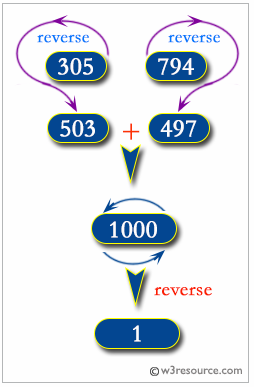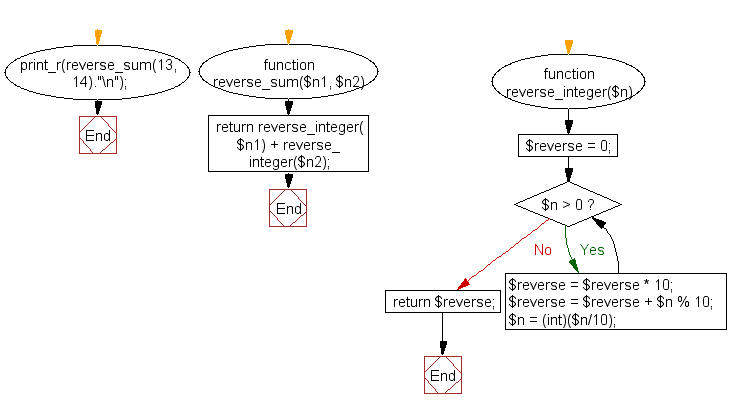PHP Challenges: Compute the sum of the two reversed numbers and display the sum in reversed form
PHP Challenges - 1: Exercise-17 with Solution
Write a PHP program to compute the sum of the two reversed numbers and display the sum in reversed form.
Input : 13, 14
Note : The result will not be unique for every number for example 31 is a reversed form of several numbers of 13, 130, 1300 etc. Therefore all the leading zeros will be omitted.
Explanation :

Sample Solution :
PHP Code :
<?php
function reverse_sum($n1, $n2)
{
return reverse_integer($n1) + reverse_integer($n2);
}
function reverse_integer($n)
{
$reverse = 0;
while ($n > 0)
{
$reverse = $reverse * 10;
$reverse = $reverse + $n % 10;
$n = (int)($n/10);
}
return $reverse;
}
print_r(reverse_sum(13, 14)."\n");
print_r(reverse_sum(130, 1)."\n");
print_r(reverse_sum(305, 794)."\n");
?>
Sample Output:
72 32 1000
Flowchart:

PHP Code Editor:
Contribute your code and comments through Disqus.
Previous: Write a PHP program to check a sequence of numbers is a geometric progression or not.
Next: Write a PHP program where you take any positive integer n, if n is even, divide it by 2 to get n / 2. If n is odd, multiply it by 3 and add 1 to obtain 3n + 1. Repeat the process until you reach 1.
What is the difficulty level of this exercise?
Test your Programming skills with w3resource's quiz.
PHP: Tips of the Day
How to Sort Multi-dimensional Array by Value?
Try a usort, If you are still on PHP 5.2 or earlier, you'll have to define a sorting function first:
Example:
function sortByOrder($a, $b) {
return $a['order'] - $b['order'];
}
usort($myArray, 'sortByOrder');
Starting in PHP 5.3, you can use an anonymous function:
usort($myArray, function($a, $b) {
return $a['order'] - $b['order'];
});
And finally with PHP 7 you can use the spaceship operator:
usort($myArray, function($a, $b) {
return $a['order'] <=> $b['order'];
});
To extend this to multi-dimensional sorting, reference the second/third sorting elements if the first is zero - best explained below. You can also use this for sorting on sub-elements.
usort($myArray, function($a, $b) {
$retval = $a['order'] <=> $b['order'];
if ($retval == 0) {
$retval = $a['suborder'] <=> $b['suborder'];
if ($retval == 0) {
$retval = $a['details']['subsuborder'] <=> $b['details']['subsuborder'];
}
}
return $retval;
});
If you need to retain key associations, use uasort() - see comparison of array sorting functions in the manual
Ref : https://bit.ly/3i77vCC
- New Content published on w3resource:
- HTML-CSS Practical: Exercises, Practice, Solution
- Java Regular Expression: Exercises, Practice, Solution
- Scala Programming Exercises, Practice, Solution
- Python Itertools exercises
- Python Numpy exercises
- Python GeoPy Package exercises
- Python Pandas exercises
- Python nltk exercises
- Python BeautifulSoup exercises
- Form Template
- Composer - PHP Package Manager
- PHPUnit - PHP Testing
- Laravel - PHP Framework
- Angular - JavaScript Framework
- Vue - JavaScript Framework
- Jest - JavaScript Testing Framework
